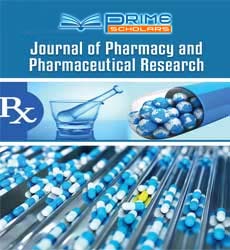Short Communication - (2022) Volume 6, Issue 1
Overview on Pharmacokinetics and Topics of Pharmaceutical Science
Chang-xiao Liu*
Department of Tianjin, Tianjin Institute of Pharmaceutical Research, China
*Correspondence:
Chang-xiao Liu, Department of Tianjin, Tianjin Institute of Pharmaceutical Research,
China,
Email:
Received: 26-Jan-2022, Manuscript No. IPIPR-22-12930;
Editor assigned: 28-Jan-2022, Pre QC No. IPIPR-22-12930(QC);
Reviewed: 11-Feb-2022, QC No. IPIPR-22-12930;
Revised: 16-Feb-2022, Manuscript No. IPIPR-22-12930(R);
Published:
23-Feb-2022, DOI: 10.21767/IPIPR.6.1.05
Abstract
Pharmacokinetics now abbreviated as PK, is part of a pharmaceutical science that is committed to determining the end of controlled substances in the living organic business. Interests include any xenobiotic compound, for example, prescription drugs, pesticides, supplements, beauty care products, and so on. It attempts to operate on the digestive tract and to find the end of the object in a second where it is directly controlled where it is completely eliminated from the body. Pharmacokinetics is the study of what living organism means in a drug, although pharmacodynamics is the study of what a drug means in a healthy form. Both combined have an impact on attraction, profit, and adverse effects, as seen in PD models.
Introduction
Pharmacokinetics expresses the body’s specific xenobiotic synthetic
post-organization through absorption and distribution
components, as well as metabolic changes in body composition
and the effects and studies of the release of drug metabolites.
Pharmacokinetic properties of synthetics are influenced
by the course of the organization and the component of the
controlled drug. This may affect the level of retention [1].
Topics of Pharmacokinetics
Models were created to enhance the consideration of multiple
cycles that occur in the relationship between a life form
and a compound substance. One of these, the multi-component
model, is the most commonly used simulation in the
real world; in any case, the complexity associated with adding
boundaries in such a display means that monocompartmental
models or more per two compact models are the most widely
used. The different compounds in which the model is divided
are commonly referred to as ADME integration. Two grinding
and extraction times can also be combined under the end of the article [2]. The investigation of these specific categories involves
the use and control of basic concepts in order to determine
co-operative features. Therefore, in order to fully understand
the power of a tree it is important to have the knowledge
of natty gritty in a variety of things, for example, the properties
of moving objects such as auxiliary materials, appropriate natural
layer features and how objects can fall [3]. The properties
of the catalyst responses that make the drug ineffective. All of
these ideas can be handled with numerical recipes with associated
image representations. The use of these models allows for
an understanding of the properties of the particles, as well as
how a particular drug will function if given data about part of its
basic components such as its strong decomposition, bioavailability
and solvency, limit drinking and life form transfer [4].
Pharmacokinetic demonstration is performed with non-component
or compartmental techniques. Non-component methods
measure the openness of a tree by examining the region
under the bend of the fixing time frame. Computer systems
measure the drawing time of a correction using car models.
Non-phase strategies are often flexible because they do not expect
to be a specific commission model and produce equally
accurate results sufficient in bioequivalence equity studies [5].
Conclusion
The end result of the changes that medicine undergoes in the
biological industry and the guidelines that determine this conclusion
depend on a variety of related factors. Various active
models were created to improve pharmacokinetics research.
These models are based on the concept of a living business as
a variety of related compounds. A little complicated thought is
to consider a living being as a single entity. This monocompartmental
model assumes that the plasma concentration of a drug
is a true indication of a drug’s concentration in different fluids
or tissues and that drug disposal is directly related to drug regulation
in the organism.
REFERENCES
- Ruiz-Garcia A, Bermejo M, Moss A, Casabo VG (2008) Pharmacokinetics in drug discovery. J Pharm Sci. 97 (2): 654â??90.
[Crossref] [Pubmed] [Googlescholar]
- Wienken CJ, Baaske P, Rothbauer U, Braun D, Duhr S (2010) Protein-binding assays in biological liquids using microscale thermophoresis. Nat Commun. 1 (7): 100.
[Crossref] [Pubmed] [Googlescholar]
- Hsieh Y, Korfmacher WA (2006) Increasing speed and throughput when using HPLC-MS/MS systems for drug metabolism and pharmacokinetic screening. Curr Dru Meta. 7 (5): 479â??89.
[Crossref] [Pubmed] [Googlescholar]
- Covey TR, Lee ED, Henion JD (1986) High-speed liquid chromatography/tandem mass spectrometry for the determination of drugs in biological samples. Anal. Chem. 58 (12): 2453â??60.
[Crossref] [Pubmed] [Googlescholar]
- Bonate PL (2005) Recommended reading in population pharmacokinetic pharmacodynamics. AAPS J. 7 (2): E363â??73.
[Crossref] [Pubmed] [Googlescholar]
Citation: Chang-xiao L (2022) Overview on Pharmacokinetics and Topics of Pharmaceutical Science. J Pharm Pharm Res Vol.6
No.1:05
Copyright: © L Chang-xiao. This is an open-access article distributed under the terms of the Creative Commons Attribution License, which permits unrestricted use, distribution, and reproduction in any medium, provided the original author and source
are credited.

